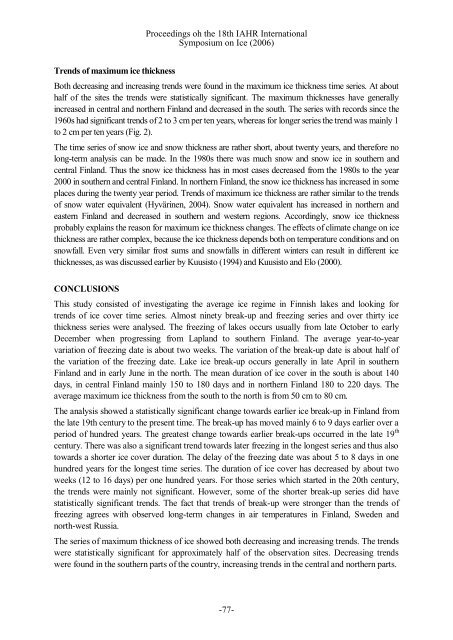LONG-TERM TRENDS IN LAKE ICE COVER IN FINLAND - River Ice
LONG-TERM TRENDS IN LAKE ICE COVER IN FINLAND - River Ice
LONG-TERM TRENDS IN LAKE ICE COVER IN FINLAND - River Ice
Create successful ePaper yourself
Turn your PDF publications into a flip-book with our unique Google optimized e-Paper software.
Proceedings oh the 18th IAHR InternationalSymposium on <strong>Ice</strong> (2006)Trends of maximum ice thicknessBoth decreasing and increasing trends were found in the maximum ice thickness time series. At abouthalf of the sites the trends were statistically significant. The maximum thicknesses have generallyincreased in central and northern Finland and decreased in the south. The series with records since the1960s had significant trends of 2 to 3 cm per ten years, whereas for longer series the trend was mainly 1to 2 cm per ten years (Fig. 2).The time series of snow ice and snow thickness are rather short, about twenty years, and therefore nolongterm analysis can be made. In the 1980s there was much snow and snow ice in southern andcentral Finland. Thus the snow ice thickness has in most cases decreased from the 1980s to the year2000 in southern and central Finland. In northern Finland, the snow ice thickness has increased in someplaces during the twenty year period. Trends of maximum ice thickness are rather similar to the trendsof snow water equivalent (Hyvärinen, 2004). Snow water equivalent has increased in northern andeastern Finland and decreased in southern and western regions. Accordingly, snow ice thicknessprobably explains the reason for maximum ice thickness changes. The effects of climate change on icethickness are rather complex, because the ice thickness depends both on temperature conditions and onsnowfall. Even very similar frost sums and snowfalls in different winters can result in different icethicknesses, as was discussed earlier by Kuusisto (1994) and Kuusisto and Elo (2000).CONCLUSIONSThis study consisted of investigating the average ice regime in Finnish lakes and looking fortrends of ice cover time series. Almost ninety breakup and freezing series and over thirty icethickness series were analysed. The freezing of lakes occurs usually from late October to earlyDecember when progressing from Lapland to southern Finland. The average yeartoyearvariation of freezing date is about two weeks. The variation of the breakup date is about half ofthe variation of the freezing date. Lake ice breakup occurs generally in late April in southernFinland and in early June in the north. The mean duration of ice cover in the south is about 140days, in central Finland mainly 150 to 180 days and in northern Finland 180 to 220 days. Theaverage maximum ice thickness from the south to the north is from 50 cm to 80 cm.The analysis showed a statistically significant change towards earlier ice breakup in Finland fromthe late 19th century to the present time. The breakup has moved mainly 6 to 9 days earlier over aperiod of hundred years. The greatest change towards earlier breakups occurred in the late 19 thcentury. There was also a significant trend towards later freezing in the longest series and thus alsotowards a shorter ice cover duration. The delay of the freezing date was about 5 to 8 days in onehundred years for the longest time series. The duration of ice cover has decreased by about twoweeks (12 to 16 days) per one hundred years. For those series which started in the 20th century,the trends were mainly not significant. However, some of the shorter breakup series did havestatistically significant trends. The fact that trends of breakup were stronger than the trends offreezing agrees with observed longterm changes in air temperatures in Finland, Sweden andnorthwest Russia.The series of maximum thickness of ice showed both decreasing and increasing trends. The trendswere statistically significant for approximately half of the observation sites. Decreasing trendswere found in the southern parts of the country, increasing trends in the central and northern parts.-77-
















